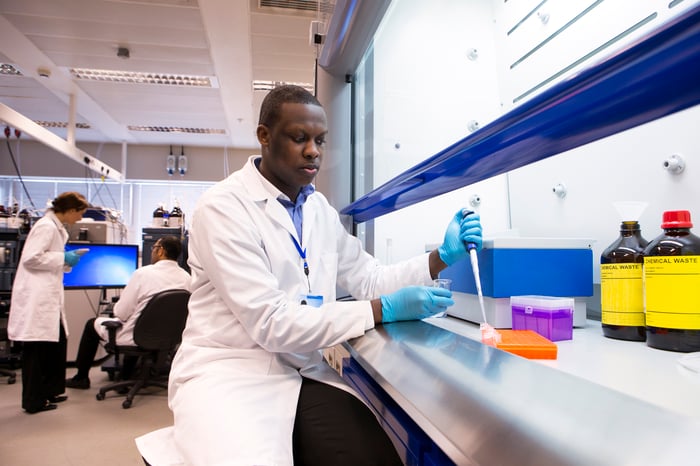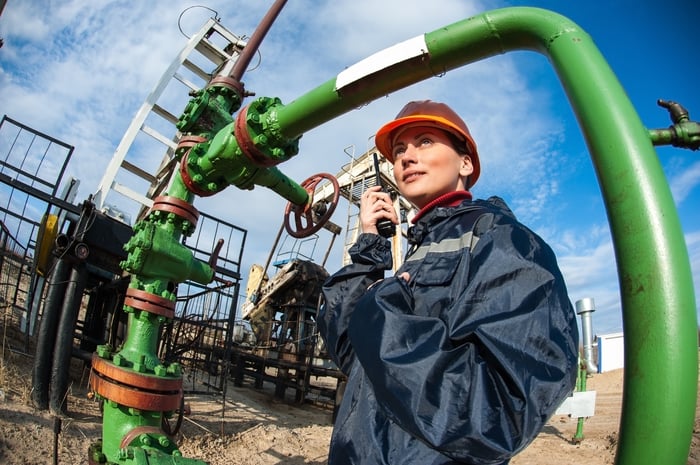There are a lot of ways to make money on Wall Street. But if there's one common theme among the best-performing portfolios, it's that they're often reliant on dividend stocks.
In 2013, J.P. Morgan Asset Management released a report that demonstrated just how dominant dividend stocks are, relative to public companies that don't pay a dividend. Between 1972 and 2012, companies that initiated and grew their payouts averaged an annual gain of 9.5%. By comparison, non-dividend-paying stocks only managed a meager annualized return of 1.6% over the same time frame.
These results shouldn't be a surprise. Since most dividend stocks are profitable and have time-tested operating models, they're the ideal place for long-term investors and income seekers to park their money.
The quandary for income seekers is that they want the most income possible with the least amount of risk. However, risk and yield tend to be correlated once you get into the high-yield category (above 4%).

Image source: Getty Images.
But that's not the case with the following five high-yield stocks. These time-tested companies should continue to deliver for investors via share-price appreciation and yield. I believe they can double your initial investment by 2029 (or sooner).
Annaly Capital Management: 10.3% yield
For income seekers who'd prefer the dividend to do most of the heavy lifting, mortgage real estate investment trust (REIT) Annaly Capital Management (NLY 2.10%) is a good bet to double your money by or before 2029. If you were to reinvest your payouts at this 10.3% yield, Annaly's dividend alone would double your initial investment in seven years.
Mortgage REITs like Annaly aim to borrow money at lower short-term rates to purchase mortgage-backed securities (MBS) with higher long-term yields. The goal here is to maximize the difference between the average long-term MBS yield and the average borrowing rate, which is known as net interest margin. Typically, as the yield curve steepens during an economic recovery, net interest margins widen. Thus, as the U.S. economy finds its footing, Annaly's core operations and profit potential should improve.
Annaly is also aided by its ability to prudently lean on leverage to pump up its earning potential. Since the bulk of its assets are agency securities -- i.e., those protected from default by the federal government -- Annaly can borrow money to a greater degree in order to increase its profits and fund its juicy dividend.
As one final note, over the past two decades, Annaly has averaged around a 10% dividend yield, and it's paid out over $20 billion in dividends since its inception nearly a quarter-century ago.

Image source: Getty Images.
AbbVie: 4.4% yield
On the other end of the high-yield dividend spectrum, at least on this list, is pharmaceutical stock AbbVie (ABBV 1.36%). Considering its 4.4% yield, its modest growth potential, and its insane value proposition, AbbVie has all the tools needed to double investors' money by 2029, if not sooner.
There's no question that anti-inflammatory drug Humira is going to play a big role in AbbVie's long-term success. Prior to the mammoth sales associated with coronavirus vaccines, Humira was the top-selling drug in the world. It has 10 approved indications in the U.S., 14 internationally, and is pacing nearly $20 billion in annual sales for 2021, based on the $9.94 billion registered through the first six months of the year. Even with the potential for biosimilar competition in the U.S. in the coming years, Humira's multiple approved indications and generally strong pricing power provide a runway for AbbVie to generate significant cash flow from its top drug.
Beyond Humira, AbbVie has turned to acquisitions to diversify its revenue stream and further shore up its cash flow. In May 2020, it completed a cash-and-stock deal to buy Allergan. Aside from being immediately accretive to earnings, the deal provides added cash flow for research and development and gives AbbVie another blockbuster presence with Botox, which has cosmetic and therapeutic applications.
At less than nine times forward earnings, AbbVie looks every part a steal for value investors and income seekers.

Image source: Getty Images.
Altria Group: 7.1% yield
I'll be the first to admit that tobacco stocks aren't the sexy growth story they once were. But when push comes to shove, few industries have more consistently delivered for investors over the long run. By 2029, Altria Group (MO 1.03%), the company behind the premium Marlboro cigarette brand in the U.S., is a good bet to double investors' money.
To state the obvious, tobacco volume metrics have been headed in the wrong direction for decades. As people have become better educated about the negative health effects of tobacco use, fewer adults have chosen to light up. Interestingly, though, this hasn't hurt Altria as much as you'd think. The company has exceptionally strong pricing power, thanks in part to the addictive nature of nicotine, and has been able to raise prices to offset cigarette-volume declines.
What's more, Altria is aggressively investing in its future. It's been introducing the IQOS heated tobacco system (licensed in the U.S. from Philip Morris International) to a number of new U.S. markets and holds a 45% equity stake in Canadian marijuana stock Cronos Group. Expect Altria to work hand in hand with Cronos to develop vape products and establish a marketing strategy.
Since Altria offers investors a dividend yield of 7.1%, only modest share-price appreciation would be needed for Altria to double your money by or before 2029.

Image source: Getty Images.
IBM: 4.7% yield
For the past decade, IBM (IBM 1.30%) has had about the same amount of appeal as watching paint dry. The tech stalwart waited too long to shift its focus to cloud computing. As a result, it's seen sales for its legacy operations go in reverse. But following a decade of transformation, a new IBM is blossoming that can, once again, deliver for its shareholders.
When the June quarter came to a close, IBM reported $7 billion in cloud revenue, which was up 13% from the prior-year period. More importantly, cloud sales made up 37% of total revenue. Since cloud margins are considerably higher than the margins associated with IBM's legacy operations, they're the key to growing the company's operating cash flow. As a reminder, IBM loves to use its cash flow to pay its juicy 4.7% dividend, buy back its stock, and make bolt-on acquisitions (mostly in the cloud space).
It's also worth pointing out that IBM chose to focus on hybrid-cloud solutions -- those that combine public and private clouds -- allowing for data to be shared between the two platforms. The hybrid cloud is perfect for big-data projects, which is something IBM has always excelled at. It's also ideal for a hybrid-working world, with remote workforces a common theme since the pandemic began.
IBM is unlikely to return to its former glory. However, a doubling of your initial investment by 2029 vis-à-vis dividend reinvestment and share-price appreciation seems very doable.

Image source: Getty Images.
Enterprise Products Partners: 8.3% yield
A final high-yield dividend stock that can use its superior payout and share-price appreciation to double your money by 2029 or sooner is master-limited-partnership Enterprise Products Partners (EPD 0.09%).
After last year, I can imagine the idea of owning oil stocks is a low priority for some investors. That's because an historic drawdown in crude oil demand ravaged the operating performance and balance sheets of most drillers.
However, Enterprise Products Partners was hardly fazed because it's a midstream operator. In other words, it controls more than 50,000 miles of pipeline and 14 billion cubic feet of natural gas storage space, in addition to more than a dozen processing facilities.
The company's take-or-pay contracts are set up in such a way that a majority of its revenue and cash flow is highly transparent. This allows the company to outlay capital for infrastructure projects without having to worry about weighing down its profit potential or adversely impacting its lucrative dividend, which stood at 8.3%, as of this past weekend.
Something else noteworthy about Enterprise Products Partners is its dividend. The company has raised its base annual payout for 22 consecutive years, and its distribution coverage ratio didn't drop below 1.6 during the pandemic (anything below 1 would signify an unsustainable payout). With incredible cash flow clarity and a willingness to spend on new infrastructure projects, Enterprise Products Partners is a good bet to double investors' money by 2029.





